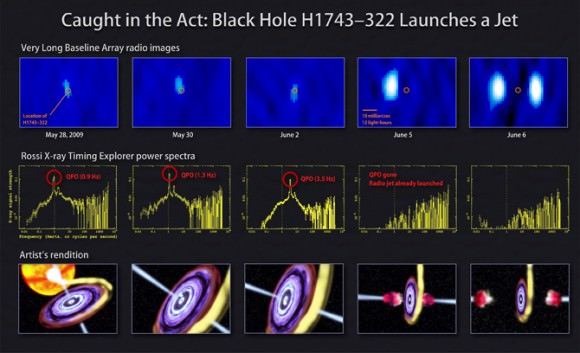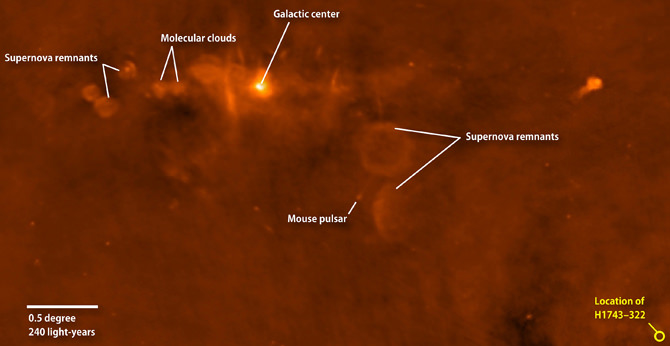[/caption]
In mid-2009 a binary star system cataloged as H H1743–322 shot off something very unusual. Poised about 28,000 light years distant in the direction of the constellation of Scorpius, this rather ordinary system made up of a normal star and unknown mass black hole was busy exchanging mass. The pair orbits in mere days with a stream of material flowing continuously between them. This gas causes a flat accretion disk measuring millions of miles across to form and it is centered on the black hole. As the matter twirls toward the center, it becomes compressed and heats to tens of millions of degrees, spitting out X-rays… and bullets.
Utilizing data from NASA’s Rossi X-ray Timing Explorer (RXTE) satellite and the National Science Foundation’s (NSF) Very Long Baseline Array (VLBA) radio telescope, an international team of astronomers were able to confirm the moment a black hole located within our galaxy fired a super speedy clump of gas into surrounding space. Blasting forth at about one-quarter the speed of light, these “bullets” of ionized gas are hypothesized to have originated from an area just outside the black hole’s event horizon.
“Like a referee at a sports game, we essentially rewound the footage on the bullets’ progress, pinpointing when they were launched,” said Gregory Sivakoff of the University of Alberta in Canada. He presented the findings today at the American Astronomical Society meeting in Austin, Texas. “With the unique capabilities of RXTE and the VLBA, we can associate their ejection with changes that likely signaled the start of the process.”
As we have learned, some of the matter headed toward the center of a black hole can be ejected from the accretion disk as opposing twin jets. For the most part, these jets are a constant stream of particles, but can sometimes form into strong “outflows” which get spit out – rapid fire – as gaseous blobs. In early June 2009, H1743–322 did just that… and astronomers were on hand observing with RXTE, the VLBA, the Very Large Array near Socorro, N.M., and the Australia Telescope Compact Array (ATCA) near Narrabri in New South Wales. During this time they were able to confirm the happenings through X-ray and radio data. From May 28 to June 2, things were nominal “though RXTE data show that cyclic X-ray variations, known as quasi-periodic oscillations or QPOs, gradually increased in frequency over the same period” and by June 4th, ATCA verified that activity had pretty much sloughed off. By June 5th, even the QPOs were gone.
Then it happened…
On the same day that everything went totally quiet, H1743–322 fired off a bullet! Radio emissions jumped and a highly accurate and detailed VLBA image disclosed a energetic missile of gas blasting forth along a jet trajectory. The very next day a second bullet took out in the opposite direction. But this wasn’t the curious part of the event… It was the timing. Up to this point, researchers speculated that a radio outburst accompanied the firing of the gas bullet, but VLBA information showed they were launched around 48 hours in advance of the major radio flare. This information will be published in the Monthly Notices of the Royal Astronomical Society.

“This research provides new clues about the conditions needed to initiate a jet and can guide our thinking about how it happens,” said Chris Done, an astrophysicist at the University of Durham, England, who was not involved in the study.
These are just mini-ammo compared to what happens in the center of an active galaxy. They don’t just fire bullets – they blast off cannons. A massive black hole weighing in a millions to billions of times the mass of the Sun can shoot off its load across millions of light years!
“Black hole jets in binary star systems act as fast-forwarded versions of their galactic-scale cousins, giving us insights into how they work and how their enormous energy output can influence the growth of galaxies and clusters of galaxies,” said lead researcher James Miller-Jones at the International Center for Radio Astronomy Research at Curtin University in Perth, Australia.
Original Story Source: NASA News Feature.


Can shoot off it’s load. Article approved. Great science, great imagery. 🙂
Here’s the link to the relevant paper: Disc-jet coupling in the 2009 outburst of the black hole candidate H1743-322.
Wherever is accretion it is accompanied by jets. That cannot be coincidence. And still no one knows how – that’s cool. 😉
Interesting content sharing
http://www.simplyrichhome.com
Regards
Richard
108 Easy Ways To Make Money | Secrets On How To Make Money Guide
$1,868,988.67 + $188,383.87 Deposited In Your Bank Account Life Can Turn 360 degrees for you
http://www.simplyrichhome.com
Black holes are a bit like toilets in a way. The drain can swallow up only so much at once. Try to flush too much down and it back flows. In the case of a black hole the rapid appearance of matter near it leads to rapid heating and expansion that is ejected away from the BH.
LC
If black holes are toilets… is Hawking radiation a black hole’s smell?
I think, you don’t want to go into that too deeply, do you?
As a woman, aged 40, possibly due to age, divorce, children, family and other reasons, I do not believe in the idea of “fall in love again”. But my friend introduced me to a fantastic website,
RichFlirt.org…where I not only found a rich “him”, but also lived a better life. So try this site, never be alone any more, and believe in yourself. cute guys and pretty girls are all in here online chatting. come join us.